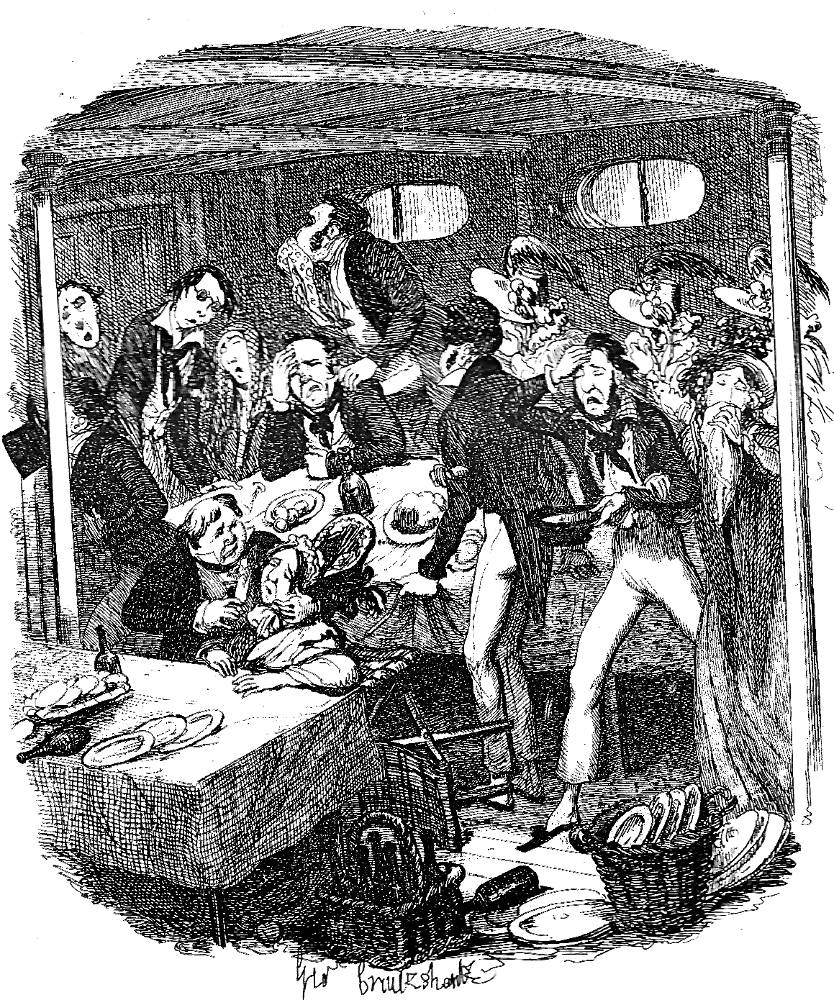
Mr. and Mrs. Caudle take a Trip to Boulogne — half-page wood-engraving for "The Twenty-Fifth Lecture" in Mrs. Caudle's Curtain Lectures, first published in the Punch; or, The London Charivari number for26 July 1845 instalment, "Mrs. Caudle, wearied of Margate, has 'a great desire to see France'," p. 128. Wood-engraving 8.7 high x 9.5 cm wide, vignetted; forty-first illustration in the third edition. As Job and Margaret Caudle shake hands with Miss. Prettyman on the Margate steamer wharf, in the background, other middle-aged couples are preparing to embark for France with their steamer-trunks (right). The heavy-faced gentleman to the left with his pencil-thin moustache looks French rather than English, as Keene implies that the tourist traffic is mutual rather than just Saxons' visiting Gallic shores.
Scanned image and text by Philip V. Allingham. [You may use this image without prior permission for any scholarly or educational purpose as long as you (1) credit the person who scanned the image and (2) link your document to this URL.]
Passage Illustrated
"You know that I always wanted to go to France; and you bring me down here only on purpose that I should see the French cliffs —; just to tantalise me, and for nothing else. If I'd remained at home —; and it was against my will I ever came here — I should never have thought of France; but —; to have it staring in one's face all day, and not be allowed to go! it's worse than cruel, Mr. Caudle —; it's brutal. Other people can take their wives to Paris; but you always keep me moped up at home. And what for? Why, that I may know nothing —; yes; just on purpose to make me look little, and for nothing else.
"Heaven bless the woman? Ha! you've good reason to say that, Mr. Caudle; for I’m sure she's little blessed by you. She's been kept a prisoner all her life — has never gone anywhere —; oh yes! that’s your old excuse, —; talking of the children. I want to go to France, and I should like to know what the children have to do with it? They're not babies now —; are they? But you’ve always thrown the children in my face. If Miss Prettyman —; there now; do you hear what you've done — shouting in that manner? The other lodgers are knocking overhead: who do you think will have the face to look at 'em to-morrow morning? I sha'n't —; breaking people's rest in that way!
"Well, Caudle —; I declare it's getting daylight, and what an obstinate man you are! —; tell me, shall I go to France?"
"I forget," says Caudle, "my precise answer; but I think I gave her a very wide permission to go somewhere, whereupon, though not without remonstrance as to the place —; she went to sleep." [Lecture XXV, "Mrs. Caudle, weary of Margate, has 'a great desire to see France'," pp. 129-130]
Commentary
Although the excursion down the Thames took its toll on Mrs. Caudle, she has recuperated from her sea-sickness quickly in the Dolphin Inn, Herne Bay. When, however, the Caudles finally arrived at Margatefor a two-month beach vacation, Margaret Caudle has quickly tired of the sleepy seaside resort, and has suggested that they visit the French coast. But her motive may be more than boredom, suggests Jerrold, as she is jealous of the beautiful, young Miss Prettyman, who has just arrived in Margate to join her brother on vacation. Mrs. Caudle, however, justifies the trip to what Dickens called "Our French Watering-place," Boulogne on the English Channel, as a way of acquiring mental stimulation:
Other people can take their wives to Paris; but you always keep me moped up at home. And what for? Why, that I may know nothing —; yes; just on purpose to make me look little, and for nothing else. [112]
However, the scene of the Caudles' taking leave of Miss Prettyman on the steamer wharf as they prepare the boat bound for the French Channel port and resort of Boulogne is pure fabrication. Keene has imagined the scene, in which he has judiciously included Miss Prettyman since Margaret Caudles's jealousy over the attractive young neighbour has motivated her desire to go to France.
From the 1820s, Great Britain's General Steamship Navigation Company had been offering just a passenger service, its most popular run being London to Margate. It added regular services between London, Hamburg, Rotterdam, Antwerp, Ostend, Calais, Boulogne, Lisbon, and Gibraltar and from Brighton to Le Havre and Dieppe, with valuable mail-delivery contracts bolstering its revenues.By August 1825, the GSN was operating a fleet of fifteen steamshipsbuilt at Deptfordon the Thames.By 1833 the company was carrying mails and thousands passengers every week from London to Hamburg, Ostend, Boulogne, and Rotterdam.
George Cruikshank's Complementary Steel-engravings for "The Steam Excursion" (1839)


Above: Cruikshank's realisation of the "before" and "after" scenes on board the Gravesend steamer, "The Steam Excursion," Part 1 and "The Steam Excursion," Part 2 (1839), the latter depicting the less-than-hilarious effects of sea-sickness. [Click on image to enlarge it.]
Related Material on Leisure
- The Development of Leisure in Britain, 1700-1850
- The Development of Leisure in Britain after 1850
- Technology and Leisure in Britain after 1850
Victorian Seaside Resorts
- Blackpool
- Bognor, East Parade
- Brighton (sitemap)
- Broadstairs, Kent
- Herne Bay
- Ramsgate
- Scarborough
- The Isle of Thanet, Kent
- Whitley Bay, North Tyneside
Bibliography
Jerrold, Douglas. Mrs. Caudle's Curtain Lectures, as Suffered by the late Job Caudle.Edited from the Original MSS. by Douglas Jerrold. With a frontispiece by Leech, and as motto on the title-page, "Then, Pistol, lay thy head in Fury's lap. —; Shakespeare." London: Punch Office; Bradbury and Evans, 1846.
Jerrold, Douglas. Mrs. Caudle's Curtain Lectures. Illustrated by John Leach and Richard Doyle. London: Bradbury and Evans, 1856.
Jerrold, Douglas. Mrs. Caudle's Curtain Lectures. Illustrated by Charles Keene. London: Bradbury and Evans, 1866.
Last modified 15 December 2017